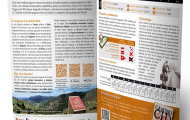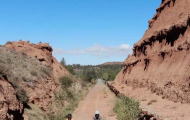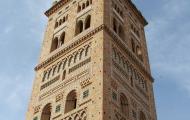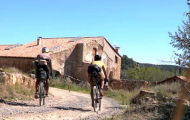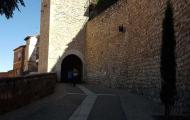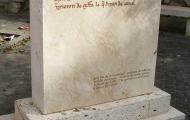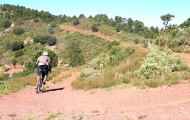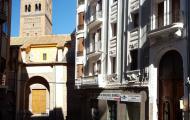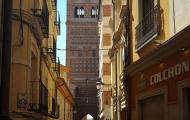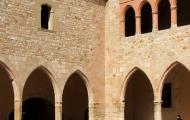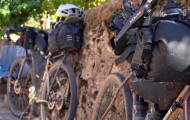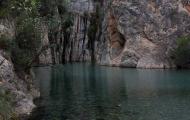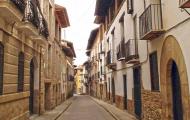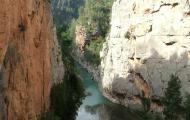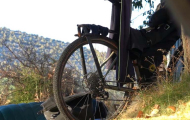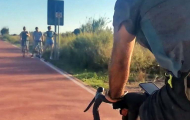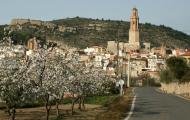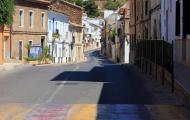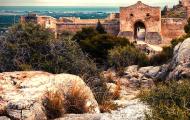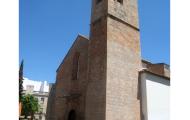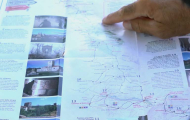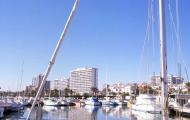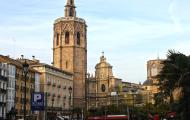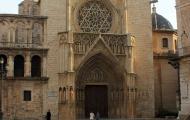The Conquest of Valencia by Gravel Bike
TERUEL - CASTELLóN - VALENCIA
The Conquest of Valencia by Gravel bike: from the mountains to the Mediterranean
This route combines some sections of mid-mountain trail, demanding for cycle tourists, with compacted or asphalted roads, flat or downhill, such as the Via Verde Ojos Negros or the Via Xurra, arriving in Valencia. Set off to conquer the city dreamt of by El Cid, but don't forget to take a dip in any of the beaches along the coast!
- Route: From Teruel to Valencia.
- Provinces: Teruel, Castellón and Valencia.
- Kilometres: 206 km approx.
- Recommended days: 3 days (68 km / day approx.)

| TECHNICAL DATA | ||
| Distance: 206 km | Cumulative ascent: 2,600 m | Physical difficulty: Medium |
| Estimated time: 3/4 days | Accumulated descent: 3,500 m | Technical difficulty: Low |
| This is a route designed for gravel bikes and is 100% cyclable, following rural roads with a good surface, comfortable tracks and lonely roads. The route does not offer significant slopes or significant complications (with the exception of stage 2 which must overcome the Sierra de la Espina), so that you can move at a good pace enjoying a variety of landscapes. | ||
Information you can download on this page
- PDF gravel guide (contains detailed maps)
- The list of accommodation.
- The list of tourist offices.
- The tourist brochure ( which you can request at any of the tourist offices along the route).
- The tracks of the route in gpx, kmz and trkformat .
Remember that in the Tourist Offices of the Camino del Cid you can get more information about each route free of charge: including brochures and the safe-conduct.
Download our travel app free of charge
We recommend you download our mobile travel app, available on iOS and Android. The app contains all our routes, you'll never get lost and you'll find information on 4,500 geo-referenced points (Cidian enclaves, places to see, accommodation, pass stamping points, etc.).
The app is free, updated daily and does not require registration. It also works in environments without coverage, so during installation and when you first turn it on, depending on your connection, it may take a few minutes to get it up and running, so be patient, it's worth it!
Plot: the conquest of Valencia
Our itinerary begins in Teruel, near Cella, the place that el Cid chooses, according to the Cantar, to gather those who want to help him conquer Valencia, and follows in his footsteps through the numerous localities of the current Valencian Community, tributaries of the historical Cid or conquered, according to the poem, by the Campeador.
The route slides towards Valencia, generally following the course of the river Palancia: it is in its valley where we find Jérica - conquered according to the Cantar by el Cid and which historically paid tribute to the Campeador - or Segorbe - also a tributary but which in the Cantar serves as a lodging for an army of 3,000 Muslim knights who move on their way to Valencia.3,000 Muslim knights who move to Alcocer to confront el Cid.
The route inevitably leads to the Mediterranean, first to Sagunto - anachronistically converted in the Cantar into el Cid's headquarters for three years - and then to El Puig, a strategic point 15 km from Valencia, which was literary and historically conquered (in 1092) by el Cid. In 1237 James I did the same, and in both cases his occupation was decisive for the conquest of the city.
All that remains is to enter the old city of Valencia through any of its historic gates - Quart or Serranos- and to walk along a stretch of the old perimeter of the Islamic walls, the remains of which, just a few stretches, are embedded in the houses of the old quarter.
El Cid took Valencia on 15 June 1094 after a gruelling siege. It is said that after the conquest he climbed the Alcazar tower to see his possessions; we take the last steps of this journey by climbing the Micalet or Miguelete, one of the symbols of this legendary city.And there is nothing better than the verses of the Cantar to describe that moment: How great is the joy that runs through the place / when my Cid won Valencia and entered the city / Those who went on foot knights become / gold and silver, who could tell you?
The narrative of the Cantar does not end here: Valencia and its surroundings are the scene of other events and battles against the Almoravids, eager to recover the city. And it is in Valencia that el Cid ended his days: historically, Rodrigo died as prince of the city in 1099. It was then, or perhaps earlier, that the legend was born.
A bit of history to help you understand this route
By the time of El Cid in the mid-11th century, the former Andalusian caliphate had split into numerous taifas (Muslim "kingdoms"). Militarily weak, they were first harassed by the rising Christian kingdoms and then invaded by the Almoravids.
Thus, the rich taifa of Valencia was coveted by the Aragonese and Catalans, and also by the Arab kings of Saragossa and Lleida, and by the Almoravids.
El Cid was able to take advantage of this situation by conquering the city of Valencia in 1094, but Almoravid pressure forced his wife, Jimena, to abandon it in 1102, three years after her husband's death.
The Almoravids were tribes from northern Morocco who entered the Peninsula in 1086, after the conquest of Toledo by Alfonso VI King of León and Castile. These tribes took control of Al-Andalus until they were displaced by the Almohads, also from Morocco, in the mid-12th century.
By then the push of the Christian kingdoms was unstoppable, although not without its difficulties, and would crystallise with the definitive conquest of Valencia by James I in 1238.
The Journey
The Conquest of Valencia section has two very distinct parts. The first, between Teruel and Jérica (Castellón), is a very rich itinerary from a historical and environmental point of view: charming villages with an intense medieval flavour, fascinating landscapes, extensive mixed Mediterranean forests, natural swimming holes, rivers, straits, and many other singularities that will more than compensate for the walker's efforts.
This part of the route, about 160 km, includes one of the most demanding sections of the whole itinerary that will force us to cross the Sierra de la Espina looking for the exit towards the coast. Teruel -capital of the Aragonese Mudejar, World Heritage Site- Mora de Rubielos, Rubielos de Mora and Jérica are the four towns declared Historical and/or Artistic Ensemble in this section.
The second part begins in Jérica: after leaving Segorbe, a historic-artistic site with a powerful Gothic heritage, the Way descends to Valencia along a technically simple route, which joins the Via Verde Ojos Negros with the Via Augusta.
Always descending, the view gradually changes, giving way between fruit and vegetable crops to a more urbanised landscape. It is then that the travellers are presented with the sight of the walls of Sagunt, facing the Mediterranean, one of the most important fortified cities in the Mediterranean and one of the oldest founded.
After passing through El Puig, the ancient Cebolla mentioned in the Canta, we can stop at one of the magnificent beaches of the Mediterranean coast, to continue on our way to Valencia, the great reward of el Cid and possibly also of the Cidian traveller of the 21st century.
There are several natural spaces of interest on this route: the savin woods of Puerto de Escandón -between Teruel and Puebla de Valverde-, the spectacular Estrechos del Mijares -between Olba and Montán- and the Middle Course of the Palancia -between Caudiel and Algar de Palancia-.
Between Sagunto and Puçol, on the coast, is the Marjal dels Moros, a wetland where endemic plants grow, frequented by a great variety of aquatic birds. This marsh reminds us of the proximity of the Mediterranean and the almost unavoidable possibility of refreshing our tired bodies on any of the beaches that bathe the warm waters of this part of the Mediterranean.
Culinary delights
Gastronomy in this area is influenced by the lie of the land. In the interior, in the mountains, the food is simple and surprisingly varied. With a traditional base, it has brought in new ingredients, such as truffle, and reinvented others, such as oils from ancient olive trees (some of which may have seen El Cid pass by).
The meat on offer includes pork, which is also responsible for the famous ham of Teruel; the rest is used for cold meats and local stews, such as La Olla. Stock from cocido and ham, as well as bread crusts and egg are essential ingredients in Pelotas de Carnaval, which are popular across the Maestrazgo region.
On the coast, the main ingredient is rice, cooked in many different ways: paella, arroz a banda, arroz al horno, arroz negro, with pumpkin, in desserts...
Fish dishes include all the Mediterranean varieties cooked in an endless number of ways, such as suquet de peix, a fish soup with a very tasty stew. While you are there, try the wines from some of the local designations of origin: Valencia and Tierra de Castelló.
And while we are speaking of drinks, don't forget to try horchata (tigernut milk) which is extremely popular in Alboraya.
Finally, this area is where some of the most famous varieties of oranges and mandarins in the world are grown: try them in season and you will no doubt be surprised by the taste of a 'real' orange.
Panoramic roads
The term ‘Singular Road' on the Way of El Cid is used for the sections of road that are of particular importance for cycling tourists or because of the countryside, history or artistic heritage. This route has the following Singular Roads:
- CV-20 between Puebla de Arenoso and Montanejos (10 km). Castellón
This is one of the best-known and most visited roads on the Way of El Cid and it is the first panoramic road to be listed by Comunidad Valenciana. The road runs in the natural area of the Straits of the River Mijares and follows said River in its descent. The river widens at the reservoir of El Arenós and narrows again near Montanejos at an attractive place that is ideal for climbing and swimming in the spa waters. Although the route is used by cycling tourists, it is important to be very careful in summer since the traffic increases considerably.
Signposting
We have designed a route that is 100% adapted for gravel bikes, following rural roads with a good surface, comfortable tracks, asphalted roads and solitary roads. There is no signposting of the gravel route as such, but as it largely coincides with the MTB and hiking routes, you should pay attention to the signposting on these sections.
We recommend that you download the track or the App, and before starting your journey, checkthe Route Alerts box in our map viewer, which shows you the most important incidents you may encounter on the route: high vegetation, interrupted crossings, road works, fallen or missing signs and any other obstacle you need to be warned of.
Climatology
You are going to travel a route with strong climatic contrasts: in less than 100 km you can find differences of 15ºC. In the area of Teruel and the mountain stages, winters are cold, dry and sunny, and summers are mild, although with a lot of thermal oscillation. The heaviest rainfall occurs in spring and autumn, with some snowfall in winter. On the other hand, from Caudiel to Valencia, the climate is fully Mediterranean, with mild winters and hot, dry summers, with average temperatures that do not drop below 18ºC from May to October and easily exceed 30ºC in the summer months. Keep an eye out for storms, especially in early autumn, when large amounts of rain fall heavily, activating numerous wadis that remain dry for the rest of the year.
Tips and recommendations
- Length of the stages: ideally, everyone should define their stages according to their personal strengths and interests: there are those who prioritise the sporting aspect, the cultural dimension of the trip or the simple sensory pleasure of enjoying landscapes and situations at a leisurely pace. The stages we propose are a mixture of all of these, and are designed so that the average cyclist in stable weather conditions can enjoy the itinerary calmly, but in the end it is you who sets the pace.
- Food and spare parts. Always carry some food in your saddlebags (sandwiches, dried fruit, energy bars...) that can help you out of a tight spot. Don't forget to take water with you. Most of the villages have fountains: don't forget to fill up your water tank before leaving them. And the same goes for bike parts: don't forget to take a repair kit with you on the road: the more complete it is, the more relaxed you'll be. If you have a mobile phone, don't forget to leave with a full battery.
- Book your accommodation in advance. Book your accommodation at the end of the stage in advance, and if you change the end of the stage, check that there is accommodation or a reception point at that point.
- Don't forget your helmet: it is legally compulsory for adults on all road sections outside the city and for children under 16 it is compulsory at all times.
- Get your safe-conduct. The safe-conduct is a personalised "passport" that you can stamp in many places along the Camino del Cid.
- Your literary guide. It seems like an unnecessary burden, but for many it is an essential guide: don't forget to bring a Cantar de mío Cid; you will be able to recreate some of its passages in situ. It is preferable that you use a modernised edition!
How to get there… and get back
To find out about the different means of transport in Teruel, click on the locality info. To arrive or leave Valencia there are numerous possibilities given that it is an important transport hub.
Rev. ALC: 21.05.2025


